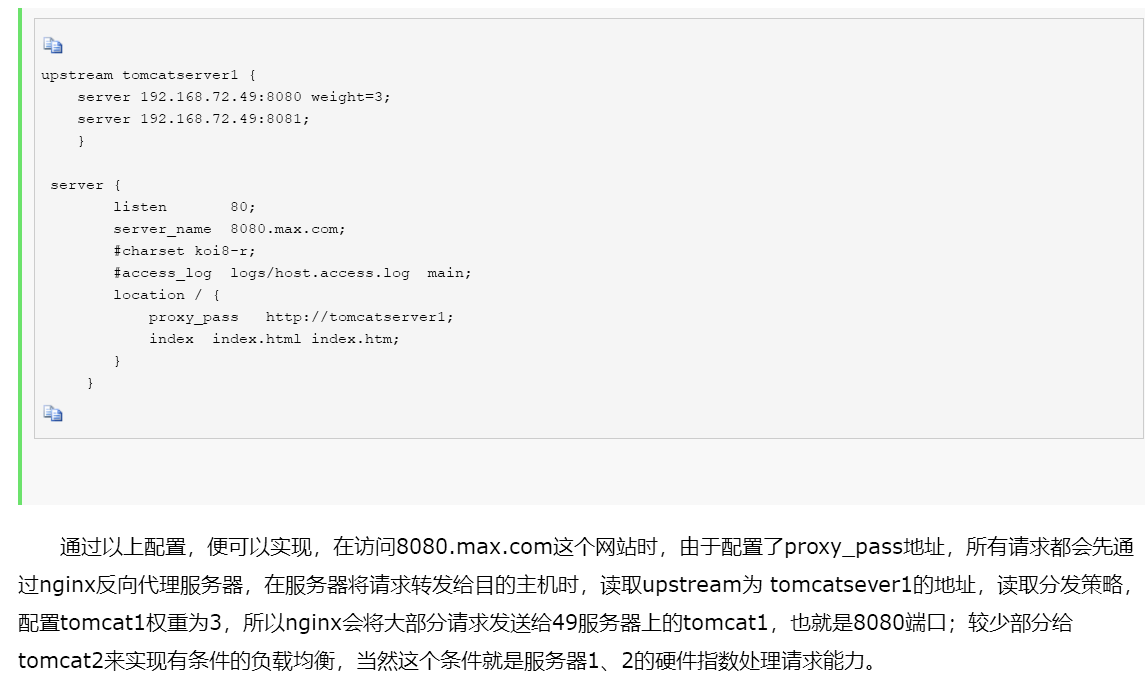nginx的学习
nginx常用命令:
在sbin目录下执行,例如:./nginx -h

-?,-h : 打开帮助信息
-v : 显示版本信息并退出
-V : 显示版本和配置选项信息,然后退出
-t : 检测配置文件是否有语法错误,然后退出
-q : 在检测配置文件期间屏蔽非错误信息
-s signal : 给一个 nginx 主进程发送信号:stop(停止), quit(退出), reopen(重启), reload(重新加载配置文件)
-p prefix : 设置前缀路径(默认是:/usr/local/Cellar/nginx/1.2.6/)
-c filename : 设置配置文件(默认是:/usr/local/etc/nginx/nginx.conf)
-g directives : 设置配置文件外的全局指令
https://www.cnblogs.com/wcwnina/p/8728391.html#!comments
在nginx.conf的注释符号位#
nginx默认的配置文件:

#user nobody;
worker_processes 1;
#error_log logs/error.log;
#error_log logs/error.log notice;
#error_log logs/error.log info;
#pid logs/nginx.pid;
events {
worker_connections 1024;
}
http {
include mime.types;
default_type application/octet-stream;
#log_format main '$remote_addr - $remote_user [$time_local] "$request" '
# '$status $body_bytes_sent "$http_referer" '
# '"$http_user_agent" "$http_x_forwarded_for"';
#access_log logs/access.log main;
sendfile on;
#tcp_nopush on;
#keepalive_timeout 0;
keepalive_timeout 65;
#gzip on;
server {
listen 80;
server_name localhost;
#charset koi8-r;
#access_log logs/host.access.log main;
location / {
root html;
index index.html index.htm;
}
#error_page 404 /404.html;
# redirect server error pages to the static page /50x.html
#
error_page 500 502 503 504 /50x.html;
location = /50x.html {
root html;
}
# proxy the PHP scripts to Apache listening on 127.0.0.1:80
#
#location ~ \.php$ {
# proxy_pass http://127.0.0.1;
#}
# pass the PHP scripts to FastCGI server listening on 127.0.0.1:9000
#
#location ~ \.php$ {
# root html;
# fastcgi_pass 127.0.0.1:9000;
# fastcgi_index index.php;
# fastcgi_param SCRIPT_FILENAME /scripts$fastcgi_script_name;
# include fastcgi_params;
#}
# deny access to .htaccess files, if Apache's document root
# concurs with nginx's one
#
#location ~ /\.ht {
# deny all;
#}
}
# another virtual host using mix of IP-, name-, and port-based configuration
#
#server {
# listen 8000;
# listen somename:8080;
# server_name somename alias another.alias;
# location / {
# root html;
# index index.html index.htm;
# }
#}
# HTTPS server
#
#server {
# listen 443 ssl;
# server_name localhost;
# ssl_certificate cert.pem;
# ssl_certificate_key cert.key;
# ssl_session_cache shared:SSL:1m;
# ssl_session_timeout 5m;
# ssl_ciphers HIGH:!aNULL:!MD5;
# ssl_prefer_server_ciphers on;
# location / {
# root html;
# index index.html index.htm;
# }
#}
}
配置文件说明:见链接:https://www.cnblogs.com/knowledgesea/p/5175711.html

########### 每个指令必须有分号结束。#################
#user administrator administrators; #配置用户或者组,默认为nobody nobody。
#worker_processes 2; #允许生成的进程数,默认为1
#pid /nginx/pid/nginx.pid; #指定nginx进程运行文件存放地址
error_log log/error.log debug; #制定日志路径,级别。这个设置可以放入全局块,http块,server块,级别以此为:debug|info|notice|warn|error|crit|alert|emerg
events {
accept_mutex on; #设置网路连接序列化,防止惊群现象发生,默认为on
multi_accept on; #设置一个进程是否同时接受多个网络连接,默认为off
#use epoll; #事件驱动模型,select|poll|kqueue|epoll|resig|/dev/poll|eventport
worker_connections 1024; #最大连接数,默认为512
}
http {
include mime.types; #文件扩展名与文件类型映射表
default_type application/octet-stream; #默认文件类型,默认为text/plain
#access_log off; #取消服务日志
log_format myFormat '$remote_addr–$remote_user [$time_local] $request $status $body_bytes_sent $http_referer $http_user_agent $http_x_forwarded_for'; #自定义格式
access_log log/access.log myFormat; #combined为日志格式的默认值
sendfile on; #允许sendfile方式传输文件,默认为off,可以在http块,server块,location块。
sendfile_max_chunk 100k; #每个进程每次调用传输数量不能大于设定的值,默认为0,即不设上限。
keepalive_timeout 65; #连接超时时间,默认为75s,可以在http,server,location块。
upstream mysvr {
server 127.0.0.1:7878;
server 192.168.10.121:3333 backup; #热备
}
error_page 404 https://www.baidu.com; #错误页
server {
keepalive_requests 120; #单连接请求上限次数。
listen 4545; #监听端口
server_name 127.0.0.1; #监听地址
location ~*^.+$ { #请求的url过滤,正则匹配,~为区分大小写,~*为不区分大小写。
#root path; #根目录
#index vv.txt; #设置默认页
proxy_pass http://mysvr; #请求转向mysvr 定义的服务器列表
deny 127.0.0.1; #拒绝的ip
allow 172.18.5.54; #允许的ip
}
}
}
项目实战配置:
#user nobody;
worker_processes 1;
#error_log logs/error.log;
#error_log logs/error.log notice;
#error_log logs/error.log info;
#pid logs/nginx.pid;
events {
worker_connections 1024;
}
http {
include mime.types;
default_type application/octet-stream;
#log_format main '$remote_addr - $remote_user [$time_local] "$request" '
# '$status $body_bytes_sent "$http_referer" '
# '"$http_user_agent" "$http_x_forwarded_for"';
#access_log logs/access.log main;
sendfile on;
#tcp_nopush on;
#keepalive_timeout 0;
keepalive_timeout 65;
#gzip on;
upstream paycenter { // 配置要分发的ip
server 136.142.59.143:31385;
server 136.142.59.144:31385;
server 136.142.59.145:31385;
server 136.142.59.146:31385;
}
upstream notify-server {
server 136.142.59.143:32578;
server 136.142.59.144:32578;
server 136.142.59.145:32578;
server 136.142.59.146:32578;
}
server {
listen 7012;
server_name 136.142.59.143; //因为server_name配置的136.142.59.143,所以请求136.142.59.143时,例如我请求http://136.142.59.143:7012/billing/pay/refundOrder,根据配置的proxy_pass,
首先通过location来过滤请求的路径,可以定位到为http://paycenter/billing/pay/;,paycenter即为上面的upstream paycenter已经配置了ip,ip的分配有具体分发策略
#charset koi8-r;
#access_log logs/host.access.log main;
location / {
root html;
index index.html index.htm;
}
location /billing/pay/ {
proxy_pass http://paycenter/billing/pay/;
}
location /notify/ {
proxy_pass http://notify-server/notify/;
}
location /contract-notify/ {
proxy_pass http://notify-server/contract-notify/;
}
#error_page 404 /404.html;
# redirect server error pages to the static page /50x.html
#
#error_page 500 502 503 504 /50x.html;
#location = /50x.html {
# root html;
#}
# proxy the PHP scripts to Apache listening on 127.0.0.1:80
#
#location ~ \.php$ {
# proxy_pass http://127.0.0.1;
#}
# pass the PHP scripts to FastCGI server listening on 127.0.0.1:9000
#
#location ~ \.php$ {
# root html;
# fastcgi_pass 127.0.0.1:9000;
# fastcgi_index index.php;
# fastcgi_param SCRIPT_FILENAME /scripts$fastcgi_script_name;
# include fastcgi_params;
#}
# deny access to .htaccess files, if Apache's document root
# concurs with nginx's one
#
#location ~ /\.ht {
# deny all;
#}
}
# another virtual host using mix of IP-, name-, and port-based configuration
#
#server {
# listen 8000;
# listen somename:8080;
# server_name somename alias another.alias;
# location / {
# root html;
# index index.html index.htm;
# }
#}
# HTTPS server
#
#server {
# listen 443 ssl;
# server_name localhost;
# ssl_certificate cert.pem;
# ssl_certificate_key cert.key;
# ssl_session_cache shared:SSL:1m;
# ssl_session_timeout 5m;
# ssl_ciphers HIGH:!aNULL:!MD5;
# ssl_prefer_server_ciphers on;
# location / {
# root html;
# index index.html index.htm;
# }
#}
}
见配置文件:只加了upstream 和server这2个,配置的运作流程是:当请求server_name 指定的136.142.59.143,由于配置了proxy_pass,所有请求都会先通过nginx反向代理服务器,在服务器将请求转发给目的主机时,读取upstream为 paycenter或者notify-server 的地址(因为我配置了2个,也会根据location后面的条件来过滤,定位到具体的server),读取分发策略,然后nginx会根据配置来分发;
nginx的location的定义:
location 有“定位”的意思,根据Uri来进行不同的定位。
例如:
location = /login {
#规则B
}
访问 http://localhost/login 将匹配规则B,具体可见链接https://www.cnblogs.com/yangzp/p/10791952.html
proxy_pass配置含义:
1.如果proxy_pass使用了URI(下面例子中paycenter地址后面部分,包括只有斜杠的情况),请求路径与loction路径的匹配部分将被替换为proxy_pass中定义的URI:
备注:paycenter可为例子中的配置upstream paycenter,配置多个ip进行分发
location /name/ {
proxy_pass http://paycenter/remote/;
}
2.如果proxy_pass没有使用URI,发给被代理服务器的请求路径和客户端发情的请求路径相同,不会被修改。
location /some/path/ {
proxy_pass http://paycenter
paycenter
;
}
demo:

参考链接:https://www.cnblogs.com/qlqwjy/p/8536779.html
posted on 2019-10-22 18:06 Cherishforchen 阅读(221) 评论(0) 编辑 收藏 举报




